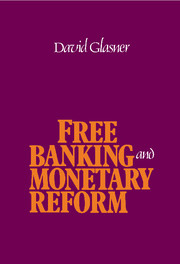Book contents
- Frontmatter
- Contents
- Preface
- Acknowledgments
- PART I A THEORY OF MONETARY INSTITUTIONS
- PART II THE UNCERTAIN PROGRESS OF MONETARY THEORY AND MONETARY REFORM
- 3 The classical theory of money
- 4 The quantity theory of money
- 5 The heyday of the gold standard, 1879–1914
- 6 The Great War, the Great Depression, and the gold standard
- 7 The Keynesian revolution and the Monetarist counterrevolution
- PART III A COMPETITIVE MONETARY REGIME
- References
- Index
7 - The Keynesian revolution and the Monetarist counterrevolution
Published online by Cambridge University Press: 16 September 2009
- Frontmatter
- Contents
- Preface
- Acknowledgments
- PART I A THEORY OF MONETARY INSTITUTIONS
- PART II THE UNCERTAIN PROGRESS OF MONETARY THEORY AND MONETARY REFORM
- 3 The classical theory of money
- 4 The quantity theory of money
- 5 The heyday of the gold standard, 1879–1914
- 6 The Great War, the Great Depression, and the gold standard
- 7 The Keynesian revolution and the Monetarist counterrevolution
- PART III A COMPETITIVE MONETARY REGIME
- References
- Index
Summary
Either the quantity of money in circulation is a datum – and the theory of Keynes can be true – or the quantity of money is fixed by the size of the cash balances which the users of money desire to hold, and the Keynesian explanation of permanent underemployment equilibrium falls to pieces.
J. Rueff, “The Fallacies of Lord Keynes' General Theory”Before his blistering attack on the Treaty of Versailles and the three leaders – Clemenceau, Lloyd-George, and Wilson – he held responsible for it, John Maynard Keynes's reputation as an expert on the arcane subject of the Indian currency, as the author of a philosophical work on probability theory, as an intimate of the Bloomsbury group, and as an effective and tireless civil servant at the Treasury was confined to a narrow circle of public officials and intellectuals. But so extraordinary was the impact of The Economic Consequences of the Peace (1919/1971) on American and European public opinion that from then on, Keynes could count on a large and attentive audience for almost anything he wrote. And after the German hyperinflation of the early 1920s seemed to confirm his warning that the Treaty of Versailles had imposed an unbearable burden on Germany, Keynes's reputation as an economic savant grew larger still.
- Type
- Chapter
- Information
- Free Banking and Monetary Reform , pp. 133 - 152Publisher: Cambridge University PressPrint publication year: 1989



